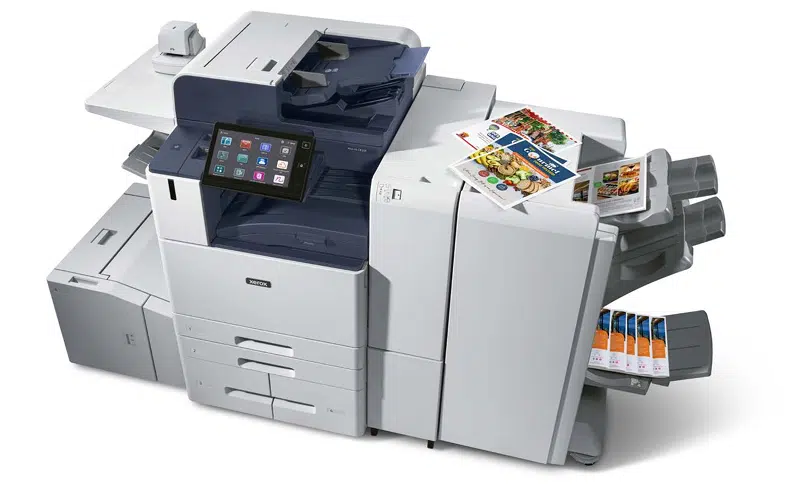
Initial Setup in the Embedded Web Server
ASSIGNING A NAME AND LOCATION TO THE PRINTER
The Description page displays the printer model information and product code or serial number. It also provides a place to assign a name and location to the printer. Asset tags let you enter unique identifiers for inventory management.
1. In the Embedded Web Server, click Properties > Description.
2. For Device Name, type a name for the device. The default Device Name is made with the Manufacturer name, Model name, and partial MAC Address.
A Host Name is different from the Device Name.
3. For Location, type the location of the device.
Note: This location appears in the list of devices on your network. Use a meaningful location name, such as a building name or number, floor, and quadrant. A meaningful location name helps users know where the device is located within your organization.
4. For Customer Asset Tag and Xerox Asset Tag, type unique identifiers as needed.
5. For Organization Information, type the Name and Unit for your organization, as needed.
6. For Geographic Location, type the latitude and longitude coordinates for the geographical location of the device.
7. Click Apply.
SETTING THE DATE AND TIME IN THE EMBEDDED WEB SERVER
1. In the Embedded Web Server, click Properties > General Setup.
2. Click Date and Time.
3. For Date and Time Setup, select an option:
• Automatic using NTP: This option allows the NTP service to set the time automatically.
• Manual (NTP Disabled): This option allows you to set the date and time manually.
4. If you are using an NTP server, select the address type. Options are IPv4 Address or Host Name. Type the appropriately formatted address, alternate address, and port numbers. The default port number is 123.
5. For Time threshold for triggering device re-sync with NTP, select a time in seconds. The range is 10–150 seconds. The default value is 110 seconds.
Note: Changes to these settings cause the printer to restart.
6. Select the date and time format, then type the date and time in the appropriate fields. To show the time in 24- hour format, select the Display 24 hour clock check box.
7. For Time Zone, select your time zone from the menu.
8. To test connectivity to the NTP server, click NTP Destination Test.
If the test succeeds, a confirmation message appears.
If the test fails, an error message appears. Verify the NTP server settings, then repeat the test. For details, refer to NTP.
9. Click Apply.
USING THE CONFIGURATION OVERVIEW PAGE
The Configuration Overview page contains links to the commonly accessed pages on the Properties tab. Use the Configuration Overview page to help you install your printer successfully.
1. In the Embedded Web Server, click Properties > Configuration Overview.
2. Select an option:
• To open the Configuration Checklist page, click View Checklist.
• To open the settings page for an app or feature, for the desired app or feature, click Settings or Setup.
• To create a clone file, for Cloning, click View. Cloning allows you to save your current printer settings to a file to use as a backup and restore file for your printer. You can also use a clone file to copy your printer settings to other printers.
RESTRICTING ACCESS TO THE PRINTER
You can lock or unlock the printer by selecting preset services and tools permissions for non-logged-in users. For details about roles and user permissions, refer to Setting Access Rights.
1. In the Embedded Web Server, click Properties > Login/Permissions/Accounting.
2. Click User Permissions.
3. For User Permission Roles, click Edit.
4. For Permission Role, for Non-Logged-User, click Edit.
5. For Print Feature, select the desired option, then click Edit.
Setting Permissions for When Users Can Print
1. For Allow Printing, select When Users Can Print, then select an option.
• Always: This option allows printing at any time. There are no time restrictions.
• Monday – Friday from: This option allows printing on weekdays. To set the printing times, use the From Time and To Time menus.
• Time of Day (Advanced): This option allows printing on specific days, during a specific time range. To set the printing days, use the From Time and To Time menus. To select the printing times, click Add Time Range. To delete, click the Trash icon.
• Never: This option restricts all printing.
2. To specify permissions for Color and Black and White printing independently, select Make color printing more restrictive than black & white printing.
3. Click Save.
Note: Not all options listed are supported on all devices. Some options apply only to a specific device model, configuration, operating system, or driver type.
Setting 1-Sided Print Permissions
1. On the 1-Sided Printing page, under Role State, select Not Allowed to require users to print 2-sided.
2. Click Save.
Setting Job Type Print Permissions
1. Under Presets, select an option:
• Allow all Job Types allows users to print any job type.
• Only Allow Secure Print ensures that users only send Secure Print jobs.
• Custom allows you to select the job types that users are allowed to send.
If you selected Custom, under Role State, next to each job type, to restrict users from using the job type, select Not Allowed.
2. To lock all job types, click the Lock icon. To unlock all job types, click the Unlock icon.
3. Click Save.
Setting Paper Tray Print Permissions
1. To restrict users from using a paper tray, under Role State, next to the paper tray, select Not Allowed.
2. To lock all job types, click the Lock icon. To unlock all job types, click the Unlock icon.
3. Click Apply.
Setting Application Print Permissions
1. For Applications, click Edit.
2. Select an application.
Note: To add an application to the list, click Add New Application, or submit a print job from that application to the printer.
3. To restrict users from using a printing method, for the printing method, select Not Allowed.
4. Click Apply.
SELECTING APPS TO APPEAR ON THE TOUCH SCREEN
Standard apps are installed and enabled on the device by default. Optionally, you can install EIP and weblet apps, which provide extra functionality. For details, refer to Weblet Management.
The Enablement option allows the administrator to disable or enable apps that appear on the control panel touch screen and the Embedded Web Server.
Note: It is not possible to disable the Jobs and Device apps, and apps that are set as entry-screen defaults.
For an app to be available for customization and personalization at the control panel, enable the app. To customize app features, refer to Customizing the Home Screen at the Control Panel.
Enabling Apps
To enable or disable apps:
1. In the Embedded Web Server, click Properties > Apps > App Enablement.
2. To enable or disable an app, on the App Enablement page, click the check box next to the app. A check mark indicates that the app is enabled.
3. Click Apply.
4. To verify that the required apps are enabled, click the Home tab. Enabled apps are listed in the Apps area of the device Home page.
Arranging the Display Order for Apps
To arrange the display order for apps on the control panel touch screen:
1. In the Embedded Web Server, click Properties > Apps > Order.
2. Select, drag, then drop the icons on the screen until they are in the preferred order.
3. Click Apply.
INSTALLING OPTIONAL SOFTWARE FEATURES
When you purchase an optional software feature, to enable it, provide a feature installation key. Some features come with an activation code that you use to request a feature installation key. Go to the Xerox® Software Activation Portal website at www.xeroxlicensing.xerox.com/fik/ to enter the activation code. The website generates a feature installation key that you can use to enable the feature.
You can also install optional software features by sending a print file. You can install features on multiple printers by sending a formatted .csv file as a print job to the printers. A Xerox representative creates this file and provides installation instructions.
Installing a Software Feature in the Embedded Web Server
1. In the Embedded Web Server, click Properties > General Setup.
2. Click Feature Installation.
3. For Feature Installation Key Entry, click Enter Installation Key, or for the feature you want to install, click Install.
4. Type the key.
5. Click Apply.
SUPPLIES PLAN
The Supplies Plan page in the Properties tab provides details about the Supplies Plan, Supplier, and Details of ordered supplies.
• In the Supplier Plan area, if a Supply Plan has not been set up and if you have received a key to set one up, to add a plan or install a feature, click Add Plan/Install Feature.
• In the Supplier area, to add a supplier, click Add Supplier. Enter the supplier details, such as Supplier Name, Contact Information, Phone Number, and Website URL, then click Add. If the user needs to delete the existing supplier, click Edit, then click Delete Supplier.
To order supplies, go to the Order Supplies page. For more information, refer to Order Supplies.
• In the Details area, details of supplies, such as Serial Number, Impression, and Sequence are displayed.
• For other plan options, click Other plan options.
Note: Plan Conversion can be done using Feature Installation Key (FIK) or a Supply Plan Key.
SUPPLIES PLAN ACTIVATION CODE
Your Xerox® equipment supplier offers supplies and service plans, such as PagePack®.
Xerox® PagePack® is a cost-per-page-based program that include all service and supplies for your device in one contract. If you have enrolled in a supplies program, you must activate the supplies plan at regular intervals. To enable your device for your purchased plan, or to get a Supplies Activation Code, contact your Xerox® equipment supplier with the device serial number.
1. In the Embedded Web Server, click Properties > General Setup.
2. Click Supplies Plan Activation Code.
3. Type the code, then click Apply.
You can also activate supplies and service plans from the control panel. To activate PagePack® Supplies Plan from the control panel, touch Device > Tools > Device Settings > Supplies > Enter PagePack Activation Code.
For more information about Xerox® supplies and service plans, contact your Xerox representative.

